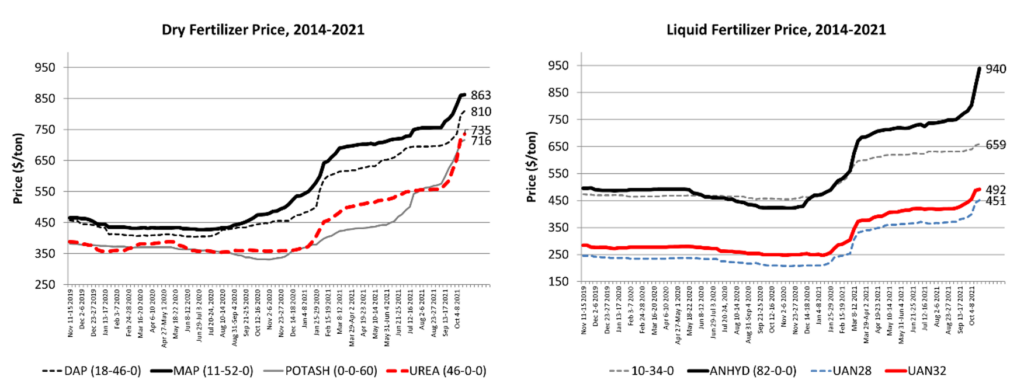Posted by Tyson Raper on behalf of the author, Dr. Aaron Smith

It’s a challenging time for crop producers to manage input price risk. Input prices for fertilizer, crop protection (chemicals), machinery, fuel, labor, rent, and insurance are up substantially compared to last year at this time. Additionally, availability and timeliness of delivery are a major concern. Fertilizer prices highlight this dramatic increase in the cost of production (graphs above). Most common fertilizers have more than doubled compared to last year. As such, producers are seeking strategies to reduce input costs. Two recommendations, as a starting point, are soil sampling (know what you’ve got) and crop selection (know current relative cost and revenue relationships for commodities produced on your farm). Unfortunately, there is no “silver bullet” to mitigate rising input costs and availability concerns. So, producers will need to be creative in their approach and consider numerous strategies.
There are limited price risk management strategies available to small or medium sized crop producers to manage input price risk (purchase timing, storage, pooling purchases, alternative marketing channels, and alternative nutrient sources, such as manure and poultry litter) and most of these strategies will not result in dramatic reductions in cost in the current environment. Tools to manage input price risk for small or medium size operations are very limited, particularly when compared to the tools available to manage output price risk (futures, options, forward contracts, hedge-to-arrive (HTA’s), minimum price contracts, etc.).
How can producers use output price risk management tools to mitigate some of the input price risk? An example can illustrate the concept. Assuming a corn yield of 180 bu/acre and a current December 2022 futures price of $5.50, provides projected revenue of $990/acre. Also assume, fertilizer expense of $300/acre. A producer could currently purchase a $4.50 December 2022 put option for 12 cents per bushel on 69 bu/acre (multiply by acres to get a production estimate and adjust for contract size). This would provide a futures price floor on 69 bu/acre at $4.38 ($4.50-$0.12) or $302/acre, thus protecting the per acre cost of fertilizers. This establishes a futures price floor on 38% of estimated production, leaving the upside price potential open. This strategy comes at a cost (12 cent premium on the protected bushels) and does not provide protection against production risk. The concept presented in this example is to offset production costs, when they occur, with output price (or revenue) risk management strategies. Crop insurance is a great risk management tool; however, if you are buying inputs now you have four months of risk with no output price or revenue protection offset. A lot can change in four months!
Producers are encouraged to evaluate strategies and use marketing tools that fit their operations. Since input and output prices are up compared to last year, risk management strategies need to be formulated based on current market risks. Remember doing nothing is a strategy, but it is rarely the optimal strategy. Bottom line – if you are purchasing inputs at high prices, you should consider securing a price (or price floor) on outputs while prices are high.
Aaron Smith
Associate Professor
Department of Agricultural & Resource Economics
325B Morgan Hall, 2621 Morgan Circle
University of Tennessee, Knoxville, TN 37996
Office: 865-974-7476 | Mobile: 865-210-2024
Email: aaron.smith@utk.edu | http://cropeconomics.tennessee.edu/

